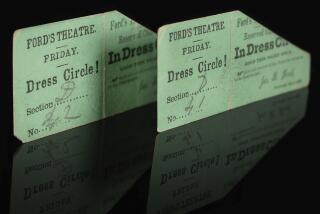Lincoln Document Rarely Exhibited : Emancipation Decree Being Put on Display
- Share via
ALBANY, N.Y. — Mona Lisa hangs in the Louvre. The Rosetta stone sits in the British Museum. But Abraham Lincoln’s handwritten Emancipation Proclamation is locked up most of the time in a New York State Library vault.
A rare public display is planned this month of the four aging, but barely fading, cream-color pages that declared freedom for slaves in the Confederate states during the Civil War.
Black History Month
To celebrate Lincoln’s birthday and Black History Month, the handwritten draft of the Sept. 22, 1862, proclamation will be exhibited in the state museum at the Empire State Plaza.
The document discloses a shrewd President with an enlightened view of mankind, but usually his renowned proclamation lies dormant in darkness. It is encapsulated in a double-chambered, 150-pound steel case filled with nitrogen gas at a temperature of 64 degrees. Each carefully preserved page rests on a sheet of pure cellulose.
Proposals to fund a permanent exhibit for the proclamation have been considered by the New York Legislature, but other priorities have taken precedence.
“We do not say publicly where the document is stored,” said John VanDerVeer Judd, a state librarian in charge of security and preservation of the proclamation and other priceless possessions in the state library system.
“We have several vaults in several different buildings, and we would rather not say which one (the proclamation is in).”
Controversial Document
No threats to steal or destroy the document have been made, James Corsaro, another state librarian, said. But the proclamation is a controversial document, he added. Recent appraisals of the Lincoln presidency by black and white historians have not all given high marks to the Illinois statesman.
Most historians agree, Corsaro says, that Lincoln was not a great abolitionist. His primary concern was unifying the country, and many conclude that the proclamation was issued as a military and political tactic more than as a humanitarian gesture.
“Today,” Corsaro says, “there are certain black people who sort of consider this in terms of just another document of a white man, a gift of the white man to the blacks, and it’s not something they respect that much.
“I don’t want to use the word ‘honky,’ a ‘honky’ document, but I think some (radical) blacks would think of it in those terms,” he says.
Purchased for $1,000
Lincoln’s proclamation, Corsaro says, is clearly the New York State Library’s most prized historical document. But the public has rarely had a chance to see it since 1865. That was when the Legislature purchased it for $1,000, two days after Lincoln’s funeral cortege had passed through this capital city.
The document’s journey from Lincoln’s hand in Washington to Albany involved statesmen, wealthy do-gooders and a raffle ticket, according to historical accounts and Corsaro.
Emily Weed Barnes, a daughter of master political strategist Thurlow Weed, and her husband, journalist William Barnes, helped organize the 1864 Army Relief Bazaar in Albany for the U.S. Sanitary Commission. The commission was a civilian-run charitable organization that raised funds for the care of wounded Union soldiers.
Mrs. Barnes used her family connections to request that the document be donated as a raffle prize. She wrote to Lincoln’s secretary of state, William H. Seward, a former New York governor, and his son, Frederick Seward, who was assistant secretary of state.
Lincoln Had Qualms
“Lincoln said he had qualms about giving the document away,” Corsaro says. “After all, it was probably the most controversial document Lincoln wrote as President.
“By the same token, he (Lincoln) realized it was something that could bring some money in that could help save some people’s lives, so he decided to donate it,” Corsaro says.
Amid the food and makeshift museum booths set up in tents at the Albany bazaar, the document some historians place on the same pedestal as the Declaration of Independence and the Magna Charta was raffled off.
As the advertisement for the raffle said: “This Proclamation is, in the opinion of the Committee, an autographic and historic treasure of more interest and importance even, than the Proclamation of January 1, 1863, which was only the necessary sequence of the September proclamation.”
(The document announced on Sept. 22, 1862, was actually a preliminary proclamation, and the formal proclamation was issued on Jan. 1, 1863.)
Historians say that Lincoln actually concluded in the spring of 1862 that general emancipation of the slaves was the correct policy to adopt, but he feared that border states might join the Confederacy if he acted too hastily. In July of that year, according to historical reports, Lincoln discussed an emancipation proclamation with his Cabinet. At Secretary of State Seward’s urging, Lincoln waited a little longer before announcing the proclamation in September. When it was announced, the document amounted to a warning to Southern states because its effective date was Jan. 1, 1863. In addition, the Sept. 22 “preliminary proclamation” may have helped prevent foreign intervention in the Civil War because the war had taken on new meaning.
About 5,000 raffle tickets for the prized proclamation were printed, but apparently only about 1,100 were sold, for $1 each. The drawing was held on March 9, 1864, and the winner was Gerrit Smith, one of New York’s largest landholders and an active abolitionist. Smith had also been a financial supporter of John Brown, a radical abolitionist who, in 1859, seized the government arsenal at Harper’s Ferry, Va., with the intention of arming a slave revolt.
Corsaro and others believe that Smith did not win the raffle by chance as much as by buying most of the tickets. “No one knows exactly how many he bought, but it’s obvious he bought an awful lot of tickets,” Corsaro says. “There’s something curious about a man who spends as much money and time and effort in the abolition movement in New York state and winning the Emancipation Proclamation. It’s not just chance.”
Ironically, Corsaro says, Smith never took possession of the document. In a letter to Barnes, the bazaar president, Smith wrote: “I have never been proud of owning houses and lands. But I confess that I am somewhat elated by being the owner of this glorious Proclamation of Freedom, in the very form in which it came from our President’s strong and honest hand.”
The letter ends with Smith telling Barnes: “You will please retain the Proclamation in your office until the purchaser shall call for it.” A year and a month later, Lincoln was assassinated. No one had come to claim the proclamation.
“I think his (Smith’s) motivation (in not taking the document) was to just support the commission and the bazaar,” Corsaro says. “You’re talking about a genuinely sincere, principled man.”
On April 26, 1865, Lincoln’s body rested in the former state Capitol. Two days after the funeral cortege departed, the state Legislature purchased the proclamation from the U.S. Sanitary Commission to honor the assassinated President.
More to Read
Sign up for Essential California
The most important California stories and recommendations in your inbox every morning.
You may occasionally receive promotional content from the Los Angeles Times.













